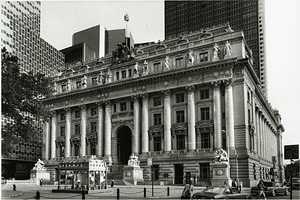Healing Through Repatriation: the Debates and Diplomacy Behind the Native American Graves Protection and Repatriation Act
Passage of Legislation
"I told him [Senator Melcher] of my concern, the concern of Indian people, and he said 'I'll do all I can.'"
~ William Tallbull, Northern Cheyenne Tribe
"The human remains issue at the time was the subject of emotional Congressional debate. In 1987, Sen. John Melcher (D.-Mont.) had introduced a bill that provided that if human remains of American Indians and associated funerary objects were found on federal lands, federal land managers would be required to repatriate them. The bill was reintroduced in the 1989 Congress and expanded to sacred objects and objects of cultural patrimony."
~ Liz Hill, Red Lake Ojibwe
William Tallbull of the Cheyenne tribe had been searching for his grandfather’s ceremonial pipe for years when he finally located it in the Smithsonian Institution’s storage. However, he was horrified to discover that the museum’s storage cabinets also held countless Native American skeletons. Tallbull took his concerns to Senator John Melcher of Montana, who began to draft legislation to protect the right of Native Americans to have their ancestors’ remains and cultural objects repatriated.

"William Tallbull accepting tape duplicates of Cheyenne wax cylinder recordings and other materials being presented by Senator John Melcher of Montana." Reid Baker / Library of Congress, 1986
Though Melcher’s “Bones Bill” was never enacted, it inspired Hawaiian Senator Daniel Inouye to sponsor the National Museum of the American Indian Act (NMAI). This law combined the massive Native American collections of the Heye Foundation and the Smithsonian, and forced them to repatriate as many items as they could, and place the rest in the newly established National Museum of the American Indian, in Washington D.C.

"Smithsonian Secretary Robert McCormick Adams signs Memorandum of Understanding with the Museum of American Indian (Heye Foundation)." Smithsonian Institute, 1989

"Exterior of the George Gustav Heye Center of the National Museum of the American Indian." Jeffrey Wayne Tinsley / Smithsonian Institution, 1991
"Installation of Compression Ring on Washington D.C. NMAI." Jeffrey Wayne Tinsley / Smithsonian Institution, 2002

"Opening of American Indian Museum with Elders on Mall." Chip Clark / Smithsonian Institution, 2004
"This is a city of monuments [Washington, D.C.], and yet there has never been a monument to Native peoples."
~ Senator Daniel Inouye
"The National Museum of the American Indian will be dedicated to the collection, preservation, and exhibition of American Indian languages, literature, history, art, anthropology, and culture."
~ President George H.W. Bush

"Washington D.C. NMAI Exterior." Ramona Sakiestewa, 2004
"The act has its origins in a legislative proposal that was introduced in 1986 and again in 1987 by Senator John Melcher of Montana. In February 1987 this committee held a hearing on that measure, and it was then that we learned that the Smithsonian Institution had in its possession approximately 14,500 human remains of Indians, Alaska Natives, and Native Hawaiians. We also learned at that time that other museums and scientific institutions were also in possession of thousands of Native American human remains, associated funerary objects, sacred items, and objects of cultural patrimony."
~ Senator Daniel Inouye
NAGPRA built upon NMAI, as well as state repatriation laws, to extend beyond the Smithsonian to require Native American remains and cultural objects to be repatriated from federally funded museums and federally owned land to federally recognized tribes.

"President George Bush Signing the Native American Graves Protection and Repatriation Act in 1990." White House Archives, 1990